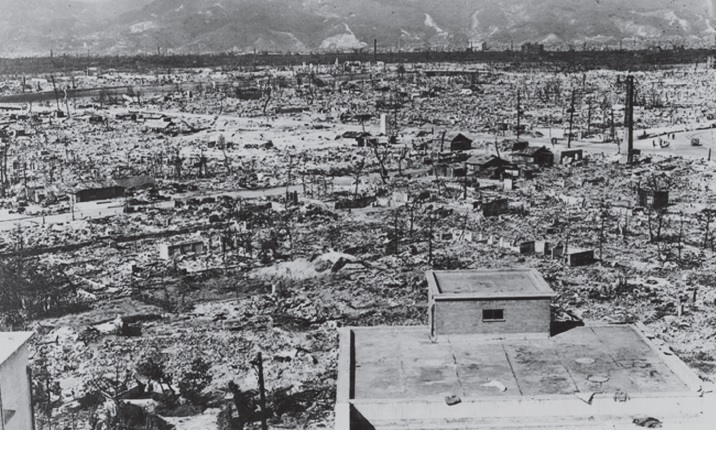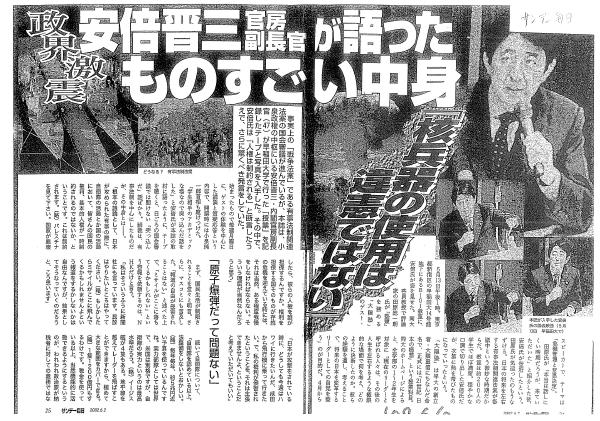1945年、アメリカは原子爆弾を広島と長崎に投下しました。核兵器を虐殺目的で故意に使用した初のケースです。日本の侵略行為とは異なり、日本が被害を受けた事実は歴史の教科書にしっかり書かれています。日本人であれば皆、様々な機会を利用して原爆被害について学ぶことができます。
広島と長崎では毎年、原爆犠牲者の霊を慰め、惨禍を再び繰り返さないことを誓うために平和祈念式典が行われます。政界で要職に就いている人も参加しています。しかし中には、同じ過ちを繰り返さないという気持ちに乏しい人もいるみたいです。
【問題発言】驚愕!安倍首相が過去に「核兵器の使用は違憲ではない」と発言していた!核兵器を使う気満々?
アメリカ様のご機嫌取りに忙しく、被爆者に寄り添う気持ちが足りないのでしょうか?こういう人に対して貴重な情報を提供しても、馬の耳に念仏、猫に小判でしょう。
さて、海外からは原爆被害がどのように見えているか、一つの例を挙げます。IPPNW(=International Physicians for the Prevention of Nuclear War:核戦争防止国際医師会議)が関連記事を書いています。以下にリンクを貼ります。
スポンサーリンク
http://www.ippnw-students.org/Japan/Hiroshima.pdf
上記リンク英文記事の一部を以下に引用します。( )内は私の日本語訳です。参考にしてください。
「During World War II, the U.S. produced three nuclear bombs. After the successful Trinity Test on July 16,1945, the U.S. detonated the remaining two bombs over Japanese cities. A uranium bomb called “Little Boy,” was dropped on Hiroshima on August 6, 1945, a plutonium bomb called “Fat Man,” on Nagasaki on August 9.」
(第二次世界大戦中、アメリカは原爆を3個製造した。1945年7月16日にトリニティ原爆実験に成功した後、残りの二つは日本の都市上空で爆発させた。リトルボーイと名付けられたウラン型原爆は1945年8月6日に広島へ投下、ファットマンと呼ばれるプルトニウム型原爆は8月9日に長崎へ投下された。)
「In Hiroshima, the T-shaped Aioi Bridge, in a populated commercial and residential area, was selected as the target. The bomb detonated at an altitude of 580 m with an explosive force equivalent to about 15,000 tons of TNT.」
(広島市内にあるT字型の相生橋が原爆投下の目標地点として選ばれた。そこは人口が密集した商業地区・住宅街であった。原爆は高度580mで炸裂し、その威力はTNT火薬に換算して約15000トン分に匹敵した。)

写真(原爆投下後の広島の状況)出典:U.S. Government / public domain
「The nuclear detonation released enormous amounts of energy, roughly 50 % of which was blast energy. The pressure wave caused by the explosion demolished almost all buildings within a 2 km radius around the hypocenter, including the major hospitals. Ear-drums and lungs burst even at a distance of several kilometers, while the wind reached velocities comparable to large hurricanes and parts of buildings. Vehicles and dead bodies hurtled as deadly projectiles through the ravaged streets.」
(核爆発により膨大なエネルギーが放出されたが、その内の約半分は運動エネルギーだ。爆心地から半径2km以内にある殆どの建物は圧力波でなぎ倒された。その中には主要な病院も含まれる。爆風は巨大ハリケーンに匹敵する速度に達し、数キロ離れたところに居ても鼓膜や肺が破裂してしまった。建物の一部・車・死体などが道中で飛ばされ凶器と化した。)
「About 35 % of the energy was released in the form of heat and led to a giant fire storm, which quickly engulfed the entire inner city. Most buildings within a radius of two kilometers fell victim to the flames. With temperatures of up to 3,000–4,000 °C around the hypocenter, all living things burned to ashes and only “nuclear shadows” remained on the pavement. Uncovered skin burned within a radius of 3.5 km. People hiding in bunkers or cellars died from carbon monoxide poisoning or suffocation. The remaining 15 % of the total energy was released in form of radioactivity.」
(放出されたエネルギーのうち約35%は熱であり、巨大な火嵐により市内のほとんどが即座に炎に包まれた。爆心地から半径2km以内の建物は殆ど焼失した。爆心地近くの温度は最大で3000〜4000℃にもなったため、全ての生き物は灰と化し、歩道に残ったのは蒸発時に出来た影だけであった。半径3.5km以内では露出した皮膚は火傷を負った。防空壕や地下室に隠れていた人たちは、一酸化炭素中毒や窒息により死亡した。原爆で放出された総エネルギーのうち、残り15%が放射線だ。)
.jpg)
写真(広島の原爆被害者) 出典:U.S. National Archives and Records Administration
「From a total of 298 medical doctors, only 28 survived the nuclear explosion. Together with about 130 nurses and 28 pharmacists, they were the only ones able to provide first aid to the survivors.」
(広島市内には全部で298人の医者がいたが、生き残ったのは28名のみであった。他に看護師約130名と薬剤師28名が生き残った。けが人に応急手当てを施せるのは彼らだけであった。)
「Most of the deaths in the first two weeks occurred due to burns, external injuries and acute radiation exposure. From the third to the eighth week, people exposed to more than 3 Sievert (Sv) of radiation died from organ failure, bloody diarrhea and vomiting or bone marrow depression with anemia, immunodeficiency and bleedings.」
(最初の2週間で亡くなった人達のほとんどは、火傷・外傷・急性放射線被爆が原因であった。第3週から8週にかけては、3シーベルト以上被爆した人達が死亡した。症状は、臓器不全・出血性下痢・嘔吐・貧血性骨髄抑制・免疫不全・出血である。)
「According to conservative estimates, at least 45,000 people died on the first day after the bombing. By the end of 1945, this number had risen to about 140,000. The exact number of casualties will never be known, however, because it is not known how many people were staying in the city during the final days of the war. Also, documents were lost in the flames; whole families perished, leaving no one to account for missing relatives; and the entire social system collapsed after the nuclear bombing, further complicating mortality assessments.」
(控えめな推定によると、少なくとも45000人が原爆当日に死んだ。1945年末までに、死者数は約14万人まで増えた。しかしながら、正確な死者数を知ることはできない。終戦時の広島市内の居住者数が判らないからだ。資料類も消失してしまった。親族が全滅して行方不明者を確認する者がいない。原爆により社会システム全体が崩壊し、それが死亡者の確認をより困難にした。)
「The first long-term effects of external radiation to be observed were keloid scars and cataracts. Starting in 1947, a non-linear increase of leukemia was noted. Leukemia incidence peaked in the first half of the 1950s and gradually declined after that. The relative risk of leukemia is presumed to be about 16 times higher for people who received 2–3 Sv of radiation as compared to the general population. Until today, leukemia incidence in Hiroshima is slightly higher than in the rest of Japan.」
(外部被爆による長期的症状として最初に見られたのは、ケロイドと白内障だ。1947年以降、白血病の増加傾向は直線的ではなかった。白血病発生数は1950年代の前半にピークとなり、その後は漸減した。2〜3シーベルトの放射線を浴びると白血病のリスクが16倍以上になると思われる。今日に至るまで、広島県の白血病発生率は他県と比べてわずかに高い。)
「On the other hand, the incidence of solid tumors is continually increasing as survivors are getting older, as is the incidence of myelodysplastic syndrome. While at first mainly thyroid cancer showed a rising incidence, cancers of the breast, stomach, large intestines, skin, liver, gallbladder, ovary and urinary bladder soon followed. The epidemiological Life Span Study (LSS), begun in 1950, showed that the incidence of cancer was proportional to the radiation exposure dose. Also, the incidence of cancer was higher in people exposed at younger age.」
(その一方で、被爆者たちが年を重ねるに連れて、固形腫瘍の発生率は持続的に増加している。骨髄異形成症候群もしかりだ。最初に急激な増加を見せたのは主に甲状腺癌だったが、乳癌・胃癌・大腸癌・皮膚癌・肝臓癌・胆嚢癌・卵巣癌・膀胱癌が後に発生するようになった。疫学的な寿命調査が1950年に始まったが、それによると、癌の発生率は被ばく線量に比例することが判っている。また、若年時に被爆した人の方が癌の発生率が高くなっている。)
「Besides cancer, other diseases with higher incidence in the survivors cohort were benign tumors, endocrine disorders, hypertension and stroke, as well as heart and liver disease. Since the frequency of chromosomal aberrations was shown to increase with radiation dose, it can be used as a “biological dosimeter.” In case of intrauterine exposure, increases in microcephaly and mental retardation were noticed in offspring of survivors.」
(被爆者の間で発生率が高い病気は癌以外では、良性腫瘍・内分泌障害・高血圧と脳卒中、そして心臓と肝臓の疾患だ。染色体異常の発生率は被爆量が多いほど増えるため、生物学的線量計としての役割を果たす。子宮内が被爆した場合、生まれて来る子供に小頭症と精神遅滞が増えることが判った。)
「The Japanese term for the survivors of the nuclear bombings is “Hibakusha.” Most of the Hibakusha still alive today were exposed to radiation at a very early age so that detrimental long-term effects and increased morbidity rates can still be expected to occur in this population. ・・・Finally, some Hibakusha groups are accusing the government of covering up the health effects of radiation on future generations for political reasons.」
(原爆の被害者のことを日本語では被爆者という。今日生存している被爆者のほとんどは幼少期に放射線を浴びたため、長期的な悪影響や疾病率増加が予想される。(中略) 被爆が将来世代にどういう影響を与えるか、政府は政治的な理由により隠ぺいしていると弾叫している被爆者グループも存在する。)
以上
